国际金融第三版外汇衍生产品市场FX Derivatives Market
- 格式:ppt
- 大小:2.09 MB
- 文档页数:47

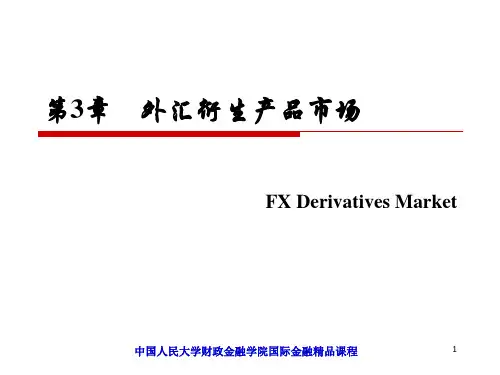
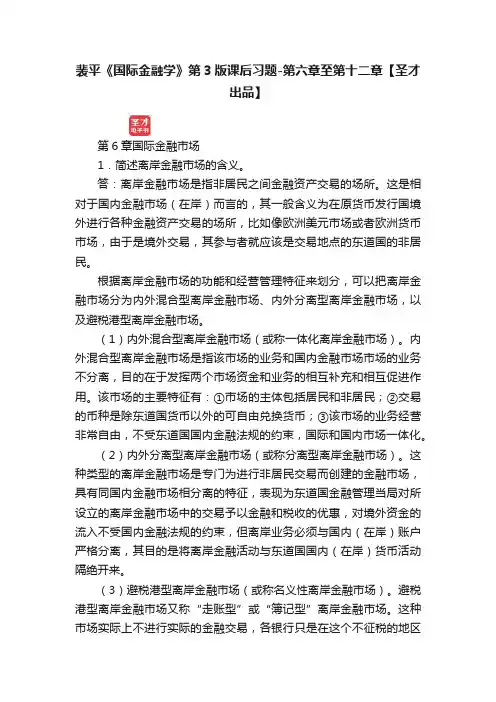
裴平《国际金融学》第3版课后习题-第六章至第十二章【圣才出品】第6章国际金融市场1.简述离岸金融市场的含义。
答:离岸金融市场是指非居民之间金融资产交易的场所。
这是相对于国内金融市场(在岸)而言的,其一般含义为在原货币发行国境外进行各种金融资产交易的场所,比如像欧洲美元市场或者欧洲货币市场,由于是境外交易,其参与者就应该是交易地点的东道国的非居民。
根据离岸金融市场的功能和经营管理特征来划分,可以把离岸金融市场分为内外混合型离岸金融市场、内外分离型离岸金融市场,以及避税港型离岸金融市场。
(1)内外混合型离岸金融市场(或称一体化离岸金融市场)。
内外混合型离岸金融市场是指该市场的业务和国内金融市场市场的业务不分离,目的在于发挥两个市场资金和业务的相互补充和相互促进作用。
该市场的主要特征有:①市场的主体包括居民和非居民;②交易的币种是除东道国货币以外的可自由兑换货币;③该市场的业务经营非常自由,不受东道国国内金融法规的约束,国际和国内市场一体化。
(2)内外分离型离岸金融市场(或称分离型离岸金融市场)。
这种类型的离岸金融市场是专门为进行非居民交易而创建的金融市场,具有同国内金融市场相分离的特征,表现为东道国金融管理当局对所设立的离岸金融市场中的交易予以金融和税收的优惠,对境外资金的流入不受国内金融法规的约束,但离岸业务必须与国内(在岸)账户严格分离,其目的是将离岸金融活动与东道国国内(在岸)货币活动隔绝开来。
(3)避税港型离岸金融市场(或称名义性离岸金融市场)。
避税港型离岸金融市场又称“走账型”或“簿记型”离岸金融市场。
这种市场实际上不进行实际的金融交易,各银行只是在这个不征税的地区(国家)建立“空壳”分行,通过这种名义上的机构在账簿上中介境外与境外的交易,以逃避税收和管制。
2.简述20世纪90年代国际金融市场的新特征。
答:20世纪90年代,金融全球化的趋势日益明显,国际金融市场上的金融活动呈现出新的特征有:(1)金融衍生产品市场迅速拓展。

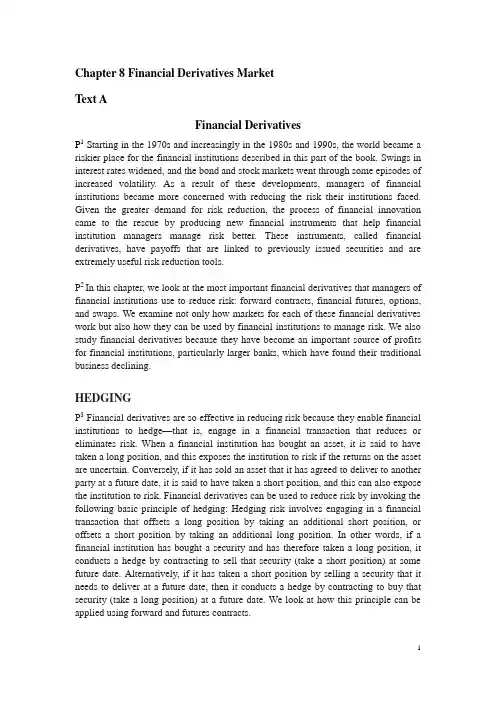
Chapter 8 Financial Derivatives MarketText AFinancial DerivativesP1 S tarting in the 1970s and increasingly in the 1980s and 1990s, the world became a riskier place for the financial institutions described in this part of the book. Swings in interest rates widened, and the bond and stock markets went through some episodes of increased volatility. As a result of these developments, managers of financial institutions became more concerned with reducing the risk their institutions faced. Given the greater demand for risk reduction, the process of financial innovation came to the rescue by producing new financial instruments that help financial institution managers manage risk better. These instruments, called financial derivatives, have payoffs that are linked to previously issued securities and are extremely useful risk reduction tools.P2 In this chapter, we look at the most important financial derivatives that managers of financial institutions use to reduce risk: forward contracts, financial futures, options, and swaps. We examine not only how markets for each of these financial derivatives work but also how they can be used by financial institutions to manage risk. We also study financial derivatives because they have become an important source of profits for financial institutions, particularly larger banks, which have found their traditional business declining.HEDGINGP3 Financial derivatives are so effective in reducing risk because they enable financial institutions to hedge—that is, engage in a financial transaction that reduces or eliminates risk. When a financial institution has bought an asset, it is said to have taken a long position, and this exposes the institution to risk if the returns on the asset are uncertain. Conversely, if it has sold an asset that it has agreed to deliver to another party at a future date, it is said to have taken a short position, and this can also expose the institution to risk. Financial derivatives can be used to reduce risk by invoking the following basic principle of hedging: Hedging risk involves engaging in a financial transaction that offsets a long position by taking an additional short position, or offsets a short position by taking an additional long position. In other words, if a financial institution has bought a security and has therefore taken a long position, it conducts a hedge by contracting to sell that security (take a short position) at some future date. Alternatively, if it has taken a short position by selling a security that it needs to deliver at a future date, then it conducts a hedge by contracting to buy that security (take a long position) at a future date. We look at how this principle can be applied using forward and futures contracts.INTEREST-RATE FORWARD CONTRACTSP4Forward contracts are agreements by two parties to engage in a financial transaction at a future (forward) point in time. Here we focus on forward contracts that are linked to debt instruments, called interest-rate forward contracts; later in the chapter, we discuss forward contracts for foreign currencies.P5Interest-rate forward contracts involve the future sale (or purchase) of a debt instrument and have several dimensions: (1) specification of the actual debt instrument that will be delivered at a future date, (2) amount of the debt instrument to be delivered, (3) price (interest rate) on the debt instrument when it is delivered, and (4) date on which delivery will take place. An example of an interest-rate forward contract might be an agreement for the First National Bank to sell to the Rock Solid Insurance Company, one year from today, $5 million face value of the 6s of 2023 Treasury bonds (that is, coupon bonds with a 6% coupon rate that mature in 2023) at a price that yields the same interest rate on these bonds as t oday‘s, say 6%. Because Rock Solid will buy the securities at a future date, it is said to have taken a long position, while the First National Bank, which will sell the securities, has taken a short position.Hedging with Interest-Rate Forward ContractsP6 Why would the First National Bank want to enter into this forward contract with Rock Solid Insurance Company in the first place?P7 To understand, suppose that you are the manager of the First National Bank and have bought $5 million of the 6s of 2023 Treasury bonds. The bonds are currently selling at par value, so their yield to maturity is 6%. Because these are long-term bonds, you recognize that you are exposed to substantial interest-rate risk: If interest rates rise in the future, the price of these bonds will fall and result in a substantial capital loss that may cost you your job. How do you hedge this risk?P8 Knowing the basic principle of hedging, you see that your long position in these bonds can be offset by an equal short position for the same bonds with a forward contract. That is, you need to contract to sell these bonds at a future date at the current par value price. As a result, you agree with another party—in this case, Rock Solid Insurance Company—to sell it the $5 million of the 6s of 2023 Treasury bonds at par one year from today. By entering into this forward contract, you have successfully hedged against interest-rate risk. By locking in the future price of the bonds, you have eliminated the price risk you face from interest-rate changes.P9 Why would Rock Solid Insurance Company want to enter into the futures contract with the First National Bank? Rock Solid expects to receive premiums of $5 million in one year‘s time that it will want to invest in the 6s of 2023, but worries that interest rates on these bonds will decline between now and next year. By using the forwardcontract, it is able to lock in the 6% interest rate on the Treasury bonds that will be sold to it by the First National Bank.Pros and Cons of Forward ContractsP10 The advantage of forward contracts is that they can be as flexible as the parties involved want them to be. This means that an institution like the First National Bank may be able to hedge completely the interest-rate risk for the exact security it is holding in its portfolio, just as it has in our example.P11However, forward contracts suffer from two problems that severely limit their usefulness. The first is that it may be very hard for an institution like the First National Bank to find another party (called a counterparty) to make the contract with. There are brokers to facilitate the matching up of parties like the First National Bank with the Rock Solid Insurance Company, but there may be few institutions that want to engage in a forward contract specifically for the 6s of 2023. This means that it may prove impossible to find a counterparty when a financial institution like the First National Bank wants to make a specific type of forward contract. Furthermore, even if the First National Bank finds a counterparty, it may not get as high a price as it wants because there may not be anyone else to make the deal with. A serious problem for the market in interest-rate forward contracts, then, is that it may be difficult to make the financial transaction or that it will have to be made at a disadvantageous price; in the parlance of financial economists, this market suffers from a lack of liquidity.P12 The second problem with forward contracts is that they are subject to default risk. Suppose that in o ne year‘s time, interest rates rise so that the price of the 6s of 2023 falls. The Rock Solid Insurance Company might then decide that it would like to default on the forward contract with the First National Bank, because it can now buy the bonds at a price lower than the agreed price in the forward contract. Or perhaps Rock Solid may not have been rock solid after all, and may have gone bust during the year, and no longer be available to complete the terms of the forward contract. Because there is no outside organization guaranteeing the contract, the only recourse is for the First National Bank to go to the courts to sue Rock Solid, but this process will be costly. Furthermore, if Rock Solid is already bankrupt, the First National Bank will suffer a loss; the bank can no longer sell the 6s of 2023 at the price it had agreed on with Rock Solid, but instead will have to sell at a price well below that, because the price of these bonds has fallen.P13The presence of default risk in forward contracts means that parties to these contracts must check each other out to be sure that the counterparty is both financially sound and likely to be honest and live up to its contractual obligations. Because this type of investigation is costly and because all the adverse selection and moral hazard problems apply, default risk is a major barrier to the use of interest-rate forward contracts. When the default risk problem is combined with a lack of liquidity, we see that these contracts may be of limited usefulness to financial institutions. Althoughthere is a market for interest-rate forward contracts, particularly in Treasury and mortgage-backed securities, it is not nearly as large as the financial futures market, to which we turn next.FINANCIAL FUTURES CONTRACTS AND MARKETSP14 Given the default risk and liquidity problems in the interest-rate forward market, another solution to hedging interest-rate risk was needed. This solution was provided by the development of financial futures contracts by the Chicago Board of Trade starting in 1975.P15 A financial futures contract is similar to an interest-rate forward contract, in that it specifies that a financial instrument must be delivered by one party to another on a stated future date. However, it differs from an interest-rate forward contract in several ways that overcome some of the liquidity and default problems of forward markets.P16To understand what financial futures contracts are all about, let‘s look at one of the most widely traded futures contracts—that for Treasury bonds, which are traded on the Chicago Board of Trade. (An illustration of how prices on these contracts are quoted can be found in the Following the Financial News box, ―Financial Futures‖.) The contract value is for $100,000 face value of bonds. Prices are quoted in points, with each point equal to $1,000, and the smallest change in price is one thirty-second of a point ($31.25). This contract specifies that the bonds to be delivered must have at least fifteen years to maturity at the delivery date (and must also not be callable—that is, redeemable by the Treasury at its option—in less than fifteen years). If the Treasury bonds delivered to settle the futures contract have a coupon rate different from the 6% specified in the futures contract, the amount of bonds to be delivered is adjusted to reflect the difference in value between the delivered bonds and the 6% coupon bond. In line with the terminology used for forward contracts, parties who have bought a futures contract and thereby agreed to buy (take delivery of) the bonds are said to have taken a long position, and parties who have sold a futures contract and thereby agreed to sell (deliver) the bonds have taken a short position.P17To make our understanding of this contract more concrete, let‘s consider what happens when you buy or sell a Treasury bond futures contract. Let‘s say that on February 1, you sell one $100,000 June contract at a price of 115 (that is, $115,000). By selling this contract, you agree to deliver $100,000 face value of the long-term Treasury bonds to the contract‘s counterparty at the end of June for $115,000. By buying the contract at a price of 115, the buyer has agreed to pay $115,000 for the $100,000 face value of bonds when you deliver them at the end of June. If interest rates on long-term bonds rise, so that when the contract matures at the end of June, the price of these bonds has fallen to 110 ($110,000 per $100,000 of face value), the buyer of the contract will have lost $5,000, because he or she paid $115,000 for the bonds but can sell them only for the market price of $110,000. But you, the seller of the contract, will have gained $5,000, because you can now sell the bonds to the buyerfor $115,000 but have to pay only $110,000 for them in the market.P18It is even easier to describe what happens to the parties who have purchased futures contracts and those who have sold futures contracts if we recognize the following fact: At the expiration date of a futures contract, the price of the contract is the same as the price of the underlying asset to be delivered. To see why this is the case, consider what happens on the expiration date of the June contract at the end of June when the price of the underlying $100,000 face value Treasury bond is 110 ($110,000). If the futures contract is selling below 110—say, at 109—a trader can buy the contract for $109,000, take delivery of the bond, and immediately sell it for $110,000, thereby earning a quick profit of $1,000. Because earning this profit involves no risk, it is a great deal that everyone would like to get in on. That means that everyone will try to buy the contract, and as a result, its price will rise. Only when the price rises to 110 will the profit opportunity cease to exist and the buying pressure disappear. Conversely, if the price of the futures contract is above 110—say, at 111—everyone will want to sell the contract. Now the sellers get $111,000 from selling the futures contract but have to pay only $110,000 for the Treasury bonds that they must deliver to the buyer of the contract, and the $1,000 difference is their profit. Because this profit involves no risk, traders will continue to sell the futures contract until its price falls back down to 110, at which price there are no longer any profits to be made. The elimination of riskless profit opportunities in the futures market is referred to as arbitrage, and it guarantees that the price of a futures contract at expiration equals the price of the underlying asset to be delivered.P19 Armed with the fact that a futures contract at expiration equals the price of the underlying asset makes it even easier to see who profits and who loses from such a contract when interest rates change. When interest rates have risen so that the price of the Treasury bond is 110 on the expiration day at the end of June, the June Treasury bond futures contract will also have a price of 110. Thus, if you bought the contract for 115 in February, you have a loss of 5 points, or $5,000 (5% of $100,000). But if you sold the futures contract at 115 in February, the decline in price to 110 means that you have a profit of 5 points, or $5,000.Hedging with Financial FuturesP20 First National Bank can also use financial futures contracts to hedge the interest rate risk on its holdings of $5 million of the 6s of 2023. To see how, suppose that in March 2007, the 6s of 2023 are the long-term bonds that would be delivered in the Chicago Board of Trade‘s T-bond futures contract expiring one year in the future, in March 2008. Also suppose that the interest rate on these bonds is expected to remain at 6% over the next year, so that both the 6s of 2023 and the futures contract are selling at par (i.e., the $5 million of bonds is selling for $5 million and the $100,000 futures contract is selling for $100,000). The basic principle of hedging indicates that you need to offset the long position in these bonds with a short position, so you have to sell the futures contract. But how many contracts should you sell? The number ofcontracts required to hedge the interest-rate risk is found by dividing the amount of the asset to be hedged by the dollar value of each contract, as is shown in Equation 1:NC =V A/VCwhere NC = number of contracts for the hedgeV A = value of the assetVC = value of each contractP21 Given that the 6s of 2023 are the long-term bonds that would be delivered in the CBT T-bond futures contract expiring one year in the future and that the interest rate on these bonds is expected to remain at 6% over the next year, so that both the 6s of 2023 and the futures contract are selling at par, how many contracts must First National sell to remove its interest-rate exposure from its $5 million holdings of the 6s of 2023? Since V A = $5 million and VC = $100,000,NC = $5 million/$100,000 = 50You therefore hedge the interest-rate risk by selling 50 of the Treasury Bond futures contracts.P22Now suppose that over the next year, interest rates increase to 8% due to an increased threat of inflation. The value of the 6s of 2023 that the First National Bank is holding will then fall to $4,039,640 in March 2008 (The value of the bonds can be calculated using a financial calculator as follows: FV = $5,000,000, PMT = $300,000, I = 8%, N = 15, PV = $4,144,052.). Thus the loss from the long position in these bonds is $960,360:Value on March 2008 @ 8% interest rate $4,144,052Value on March 2007 @ 6% interest rate -$5,000,000Loss -$ 855,948P23 However, the short position in the 50 futures contracts that obligate you to deliver $5 million of the 6s of 2023 on March 2007 has a value equal to $4,144,052, the value of the $5 million of bonds after the interest rate has risen to 8%, as we have seen before. Yet when you sold the futures contract, the buyer was obligated to pay you $5 million on the maturity date. Thus the gain from the short position on these contracts is also $855,948:Amount paid to you on March 2008,agreed upon in March 2007 $5,000,000Value of bonds delivered on March 2008@ 8% interest rate -$4,144,052Gain $ 855,948P24 Therefore the net gain for the First National Bank is zero, indicating that the hedge has been conducted successfully.P25 The hedge just described is called a micro hedge because the financial institutionis hedging the interest-rate risk for a specific asset it is holding. A second type of hedge that financial institutions engage in is called a macro hedge, in which the hedge is for the institution‘s entire portfolio. For example, if a bank has more rate-sensitive liabilities than assets, a rise in interest rates will cause the value of the bank‘s net wort h to decline. By selling interest-rate future contracts that will yield a profit when interest rates rise, the bank can offset the losses on its overall portfolio from an interest-rate rise and thereby hedge its interest-rate risk.Organization of Trading in Financial Futures MarketsP26 Financial futures contracts are traded in the United States on organized exchanges such as the Chicago Board of Trade, the Chicago Mercantile Exchange, the New York Futures Exchange, the MidAmerica Commodity Exchange, and the Kansas City Board of Trade. These exchanges are highly competitive with one another, and each organization tries to design contracts and set rules that will increase the amount of futures trading on its exchange.P27 The futures exchanges and all trades in financial futures in the United States are regulated by the Commodity Futures Trading Commission (CFTC), which was created in 1974 to take over the regulatory responsibilities for futures markets from the Department of Agriculture. The CFTC oversees futures trading and the futures exchanges to ensure that prices in the market are not being manipulated, and it also registers and audits the brokers, traders, and exchanges to prevent fraud and to ensure the financial soundness of the exchanges. In addition, the CFTC approves proposed futures contracts to make sure that they serve the public interest. The most widely traded financial futures contracts listed in the Wall Street Journal and the exchanges where they are traded (along with the number of contracts outstanding, called open interest, on March 20, 2006) are listed in Table 1.P28Given the globalization of other financial markets in recent years, it is not surprising that increased competition from abroad has been occurring in financial futures markets as well.The Globalization of Financial Futures MarketsP29 Because American futures exchanges were the first to develop financial futures, they dominated the trading of financial futures in the early 1980s. For example, in 1985, all of the top ten futures contracts were traded on exchanges in the United States. With the rapid growth of financial futures markets and the resulting high profits made by the American exchanges, foreign exchanges saw a profit opportunity and began to enter this business. By the 1990s, Eurodollar contracts traded on the London International Financial Futures Exchange, Japanese government bond contracts and Euroyen contracts traded on the Tokyo Stock Exchange, French government bond contracts traded on the Marché à Terme International de France, and Nikkei 225 contracts traded on the Osaka Securities Exchange all became among the most widely traded futures contracts in the world.P30Foreign competition has also spurred knockoffs of the most popular financial futures contracts initially developed in the United States. These contracts traded on foreign exchanges are virtually identical to those traded in the United States and have the advantage that they can be traded when the American exchanges are closed. The movement to 24-hour-a-day trading in financial futures has been further stimulated bythe development of the Globex electronic trading platform, which allows traders throughout the world to trade futures even when the exchanges are not officially open. Financial futures trading has thus become completely internationalized, and competition between U.S. and foreign exchanges is now intense.Explaining the Success of Futures MarketsP31The tremendous success of the financial futures market in Treasury bonds is evident from the fact that the total open interest of Treasury bond contracts exceeded 20,000 on March 20, 2006, for a total value of more than $2 billion (20,000 X $100,000). There are several differences between financial futures and forward contracts and in the organization of their markets that help explain why financial futures markets such as those for Treasury bonds have been so successful.P32Several features of futures contracts were designed to overcome the liquidity problem inherent in forward contracts. The first feature is that, in contrast to forward contracts, the quantities delivered and the delivery dates of futures contracts are standardized, making it more likely that different parties can be matched up in the futures market, thereby increasing the liquidity of the market. In the case of the Treasury bond contract, the quantity delivered is $100,000 face value of bonds, and the delivery dates are set to be the last business day of March, June, September, and December. The second feature is that after the futures contract has been bought or sold, it can be traded (bought or sold) again at any time until the delivery date. In contrast, once a forward contract is agreed on, it typically cannot be traded. The third feature is that in a futures contract, not just one specific type of Treasury bond is deliverable on the delivery date, as in a forward contract. Instead, any Treasury bond that matures in more than fifteen years and is not callable for fifteen years is eligible for delivery. Allowing continuous trading also increases the liquidity of the futures market, as does the ability to deliver a range of Treasury bonds rather than one specific bond.P33 Another reason why futures contracts specify that more than one bond is eligible for delivery is to limit the possibility that someone might corner the market and ―squeeze‖ traders who have sold contracts. To corner the market, someone buys up all the deliverable securities so that investors with a short position cannot obtain from anyone else the securities that they contractually must deliver on the delivery date. As a result, the person who has cornered the market can set exorbitant prices for the securities that investors with a short position must buy to fulfill their obligations under the futures contract. The person who has cornered the market makes a fortune, but investors with a short position take a terrific loss. Clearly, the possibility that corners might occur in the market will discourage people from taking a short position and might therefore decrease the size of the market. By allowing many different securities to be delivered, the futures contract makes it harder for anyone to corner the market, because a much larger amount of securities would have to be purchased to establish the corner. Corners are a concern to both regulators and the organized exchanges that design futures contracts.P34Trading in the futures market has been organized differently from trading in forward markets to overcome the default risk problems arising in forward contracts. In both types, for every contract, there must be a buyer who is taking a long position and a seller who is taking a short position. However, the buyer and seller of a futures contract make their contract not with each other but with the clearinghouse associated with the futures exchange. This setup means that the buyer of the futures contract does not need to worry about the financial health or trustworthiness of the seller, and vice versa, as in the forward market. As long as the clearinghouse is financially solid, buyers and sellers of futures contracts do not have to worry about default risk.P35To make sure that the clearinghouse is financially sound and does not run into financial difficulties that might jeopardize its contracts, buyers or sellers of futures contracts must put an initial deposit, called a margin requirement, of perhaps $2,000 per Treasury bond contract into a margin account kept at their brokerage firm. Futures contracts are then marked to market every day. What this means is that at the end of every trading day, the change in the value of the futures contract is added to or subtracted from the margin account. Suppose that after you buy the Treasury bond contract at a price of 115 on Wednesday morning, its closing price at the end of the day, the settlement price, falls to 114. You now have a loss of 1 point, or $1,000, on the contract, and the seller who sold you the contract has a gain of 1 point, or $1,000. The $1,000 gain is added to the seller‘s margin account, making a total of $3,000 in that account, and the $1,000 loss is subtracted from your account, so you now have only $1,000 in your account. If the amount in this margin account falls below the maintenance margin requirement (which can be the same as the initial requirement but is usually a little less), the trader is required to add money to the account. For example, if the maintenance margin requirement is also $2,000, you would have to add $1,000 to your account to bring it up to $2,000. Margin requirements and marking to market make it far less likely that a trader will default on a contract, thus protecting the futures exchange from losses.P36A final advantage that futures markets have over forward markets is that most futures contracts do not result in delivery of the underlying asset on the expiration date, whereas forward contracts do. A trader who sold a futures contract is allowed to avoid delivery on the expiration date by making an offsetting purchase of a futures contract. Because the simultaneous holding of the long and short positions means that the trader would in effect be delivering the bonds to itself, under the exchange rules the trader is allowed to cancel both contracts. Allowing traders to cancel their contracts in this way lowers the cost of conducting trades in the futures market relative to the forward market in that a futures trader can avoid the costs of physical delivery, which is not so easy with forward contracts.Hedging Foreign Exchange RiskP37Foreign exchange rates have been highly volatile in recent years. The large。




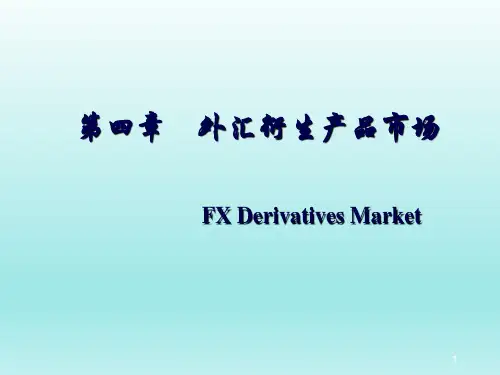
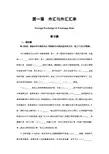
第一章外汇与外汇汇率Foreign Exchange & Exchange Rate练习题一、填空题练习说明:请结合学习情况在以下段落空白处填充适当的文字,使上下文合乎逻辑。
外汇的概念可以从两个角度来考察:其一,将一国货币兑换成另一国货币的过程,也就是(1)的外汇概念;其二,国际间为清偿债权债务关系进行的汇兑活动所凭借的手段和工具,也就是(2)的外汇概念。
通常意义上的外汇都是指后者。
外汇的主要特征体现在两个方面:外汇是以(3)表示的资产,外汇必须是可以(4)成其他形式的,或者以其他货币表示的资产。
因此,外汇并不仅仅包括可兑换的外国货币,外汇资产的形式有很多,例如,(5),(6),(7)等等。
(8)是外汇这样特殊商品的价格,又称(9),是不同货币之间兑换的比率或者比价,或者说是以一种货币表示的另一种货币的价格。
(10)和间接标价法是两种基本的汇率标价方法。
前者是指以一定单位的外国货币为标准,来计算折合多少单位的本国货币;后者是指以一定单位的本国货币为标准,来计算折合多少单位的外国货币。
目前,国际市场上通行的(11),是以美元作为标准公布外汇牌价。
汇率根据不同的标准可以分为不同的种类,例如,买入价,卖出价和中间价;即期汇率和远期汇率;(12)和套算汇率;电汇汇率,(13)和票汇汇率;官方汇率和市场汇率;贸易汇率和金融汇率;固定汇率和浮动汇率;名义汇率和实际汇率。
19世纪初到20世纪初,西方资本主义国家普遍实行的是(14)制度,各国货币都以黄金铸成,金铸币有一定的重量和成色,有法定含金量;金币可以(15)、(16)、自由输出入,具有无限清偿能力。
在这种货币制度下,汇率是相当稳定的,这是因为,两种货币汇率决定的基础是铸币平价,即两种货币(17)之比。
而各国货币法定的含金量一旦确定,一般不轻易改动,因而铸币平价是比较稳定的。
当然,金本位制度下的汇率同样会根据外汇供求关系的作用而上下浮动。
当某种货币供不应求时,汇价会上涨,超过铸币平价;反之,汇价就会下跌,低于铸币平价。
第三章外汇衍生产品市场一、本章要义外汇衍生产品通常是指从(1)-------------派生出来的外汇交易工具。
该交易的基本特征有:(2)-----------,即只要支付一定比例的(3)--------------就可以进行全额交易,不需要实际上的(4)---------------------,合约的终结一般也采用(5)----------------的方式进行,只有在到期日以(6)--------------方式履约的合约才需要买方交足货款。
因此金融衍生品的交易具有(7)-----------。
保证金越低,(8)--------------,(9)------------------。
(10)---------------,即预约买卖外汇的交易,亦即外汇买卖双方先行签订合同,约定买卖外汇的币种、数额、汇率和(11)------------------,到规定的交割日期或在约定的交割期内,再按合同规定条件,买卖双方办理交割的外汇交易。
(12)--------------,是指外汇买卖双方在有组织的交易场所内约定,以(13)--------------的方式确定的价格(汇率),在将来某日买入或卖出某一(14)----------------的某种外汇的交易活动。
(15)---------------,指期权合同的买方在向期权卖方(即立权人)支付一定的(16)------------------后,所获得的在一定时间内,按照协定汇率是否买进或卖出一定数量的外汇资产的(17)-------------。
(18)----------------,是交易双方相互交换不同(19)----------------、但(20)---------------相同和(21)---------------相等的货币及利息的业务。
外汇互换交易既涉及(22)--------------的互换,又涉及(23)-------------------的互换。